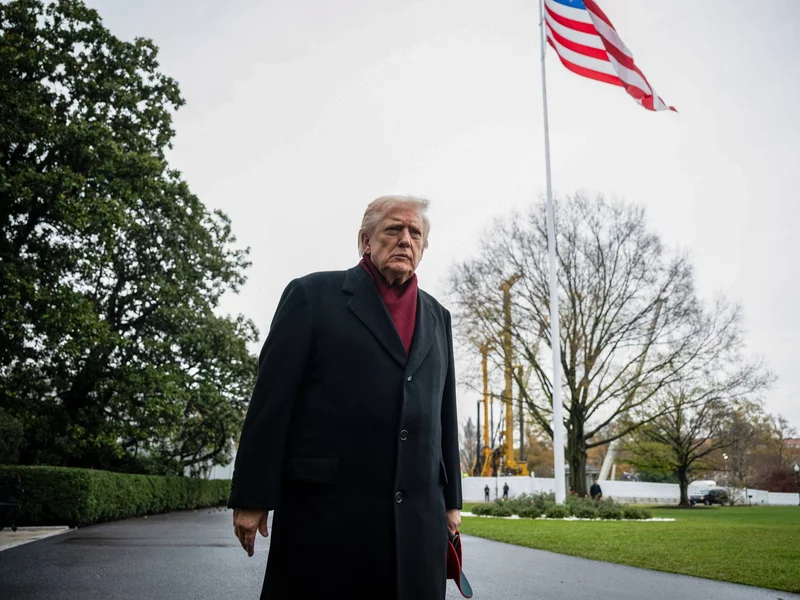US president Donald Trump has long had a penchant for utilizing “cowboy diplomacy” to get his way in the global arena. As individual who is neither a career politician nor bound by ideology, the 79-year-old billionaire showman has no compunction about defying the US Beltway’s best practices and making aggressive moves erstwhile another countries undermine America’s national interests.
His first word in office was mostly characterized by slinging mud at, and clipping the wings of, conventional western foes – whether it be ripping up the Joint Comprehensive Plan of Action (JCPOA) and waging a “maximum force campaign” against Iran; threatening to unleash “fire and fury” on North Korea while starving its already beleaguered economy of all viable gross streams; or helping Ukraine fend off further Russian aggression by sending its armed forces the anti-tank javelin missiles his predecessor Barack Obama denied Kyiv.
This time around, however, he appears to hold just as much – if not greater – contempt for any of Washington’s closest global partners. Early into his second term, Trump proposed reducing Canada to the 51st state, annexing Danish-controlled Greenland, renaming the Gulf of Mexico, and encouraging president Putin to do “whatever the hell he wants” with NATO’s delinquent European members. The latest expected US ally to find itself in the crosshairs of an increasingly erratic White home is India.
Admittedly, there were telltale signs of strained Indo-US relations at the start of this year, erstwhile Trump invited Chinese Communist organization (CCP) president Xi Jinping to his inauguration ceremony while snubbing Indian Prime Minister Narendra Modi. any months later, dehumanizing images and videos surfaced of 104 illegal Indian migrants wearing leg irons and handcuffs before being escorted like cattle onto a 40-hour repatriation flight.
Meanwhile, at the tallness of the fresh India-Pakistan flare-up, Trump not only took credit for brokering an armistice between the 2 nuclear-armed neighbours but besides went on to host arguably the most powerful figure in Pakistan, Field Marshal Asim Munir, at the Oval Office for a luncheon in mid-June. Having crossed the Rubicon and done almost everything within its capacity to alienate the “world’s largest democracy”, the US government went for broke by slapping India with extortionate 50 per cent tariffs over its record consumption of inexpensive Russian crude.
Yet, the degree to which these punitive measures will force the hand of the ruling and fiercely independent Bharatiya Janata organization (BJP) is anyone’s guess. Clearly, the goal here is to make an example of a Kremlin-friendly aspiring superpower without eliciting the monumental blowback a trade war or sanctions crusade against China would bring about. Despite its vast landmass, India lacks the natural resources, uncommon earth minerals, and another key commodities the People’s Republic boasts an abundance of – not to mention Beijing’s far superior industrial and manufacturing base comparative to that of fresh Delhi.
Following the Trump team’s tariff announcement last week, India dispatched its National safety Advisor Ajit Doval to Moscow, while Prime Minister Modi held a telephone conversation with the quasi-socialist Brazilian president and rotating BRICS head Lula da Silva which, in many ways, was tantamount to showing Uncle Sam both mediate fingers. alternatively than twisting the South Asian giant’s arm via ill-thought-out economical coercion and thrusting it into unholy alliances of convenience with arch-rival China and left-leaning Brazil, Washington would be better off utilizing immigration as its primary weapon of choice vis-à-vis India.
It is worth recalling how a temporary moratorium on issuing fresh US visitor visas to all citizens of Venezuela, as well as nullifying those previously granted, left the narco-state’s illegitimate leader Nicolàs Maduro no choice but to accept planeloads of expelled Venezuelan criminals against his will. Likewise, US Secretary of State Marco Rubio’s zero-tolerance approach towards abroad students who indulge in pro-Palestinian vandalism and now face swift deportation has seen disruptive Hamas solidarity movements on American college campuses fizzle out.
In stark contrast to its earlier 2017 iteration, the Trump 2.0 travel ban bifurcates “high-risk” jurisdictions into 2 categories: a full suspension directed at predominantly failed Sub-Saharan African and mediate east states, whose nationals are prone to overstay their welcome; and a partial entry prohibition for passport holders of another 7 impoverished nations with a lower, albeit significant, proclivity for visa abuse and criminality. Although blacklisting a fellow Quad associate that serves as a regional bulwark against China may be a stretch, little severe travel restrictions can be imposed on India if it continues to bankroll Russia’s “special military operation”.
For instance, the Department of Homeland safety (DHS) now mandates visa applicants from Malawi and Zambia to post a bond of anywhere between 5000 to 15,000 US dollars as a means of ensuring they return home. There is simply a strong argument in favour of applying specified a regulation to US-bound Indians that would not be without precedent. Back in 2013, the UK’s then Home Secretary Theresa May floated akin government aimed at combatting irregular migration from the subcontinent that had, up until a fewer months ago, impeded the long-awaited ratification of an Indo-British free trade agreement (FTA).
perceive to the latest Talk east Europe podcast episode:
Australia, on the another hand, has outright barred students from six Indian states believed to be hotbeds for human trafficking. Making it harder and costlier for citizens of India to frequent the United States will mobilize the country’s middle-class against their country’s leadership like never before, not least since there is no alternate to the “American Dream” as far as this peculiar cohort is concerned. At the same time, Modi’s “Billionaire Raj” mega-donors may view a bold decision of this kind as a precursor to a full-fledged ban on Indians and thereby lobby the BJP to distance itself from Putin’s Russia.
After all, the US remains the preferred destination for India’s advanced echelons and business elite erstwhile it comes to setting up offshore accounts, undergoing medical treatment, pursuing commercial ventures, and enrolling their children in higher education. From Washington’s standpoint, the beauty of penalizing India in this manner is that there are virtually no downsides. Any mobility-related retaliation from fresh Delhi will prove futile, as had been the case erstwhile Canadians were temporarily prevented from entering India in consequence to erstwhile Prime Minister Justin Trudeau accusing the country’s Research and Analysis Wing (RAW) of carrying out extrajudicial killings in Canada on Modi’s orders.
This is due to the fact that most Americans and Canadians who visit India are of Indian extraction and in possession of an Overseas Citizen of India (OCI) document, which affords them unfettered access to their motherland for household reunification purposes or otherwise. Nor will the US visa bond request have any bearing on sourcing talented professionals from India – the bulk of whom are healthcare practitioners and IT specialists recruited by private clinics and tech juggernauts that would have no issues forking over a recoverable 15,000 US dollar fee.
Repeated post-war calls by the Baltics, Poland and Finland to prohibit Russians from vacationing or settling down in the Schengen Area were shot down by Brussels due to fears that anti-establishment journalists and activists from the aggressor state would end up as collateral damage. Despite India increasing alarmingly authoritarian and intolerant of its non-Hindu indigenous minorities under Modi’s watch, very fewer inhabitants face life-threatening persecution for their spiritual or political beliefs that would constitute credible grounds for asylum in the United States.
Ultimately, levying prohibitive tariffs on Indian goods will upend the livelihoods of agricultural and textile workers susceptible to Modi’s demagoguery and his triumphalist spin on India asserting its sovereignty. Suggesting India totally phase out its Russian energy purchases and compensate for the ensuing shortfall by ramping up oil imports from the Gulf Cooperation Council (GCC) presupposes that the Saudi killer Prince Mohammed Bin Salman (MbS), as well as Emirati genocidaire strongman Mohamed Bin Zayed (MbZ), are someway better human beings than Vladimir Putin.
Subjecting Indian travellers to additional red tape on top of the nightmarish bureaucracy they already undergo to safe OECD visas is simply a surefire way of hitting fresh Delhi where it hurts. Ultimately, it will galvanize those who substance most within Modi’s constituency into action. Given the outsized leverage Trump wields over the Indian top brass, he must not regulation out the atomic option of yet including India in his fresh and improved travel ban list if the BJP refuses to reverse course and pull the plug on its sponsorship of Russia’s reckless adventurism in Ukraine.
Saahil Menon is an independent wealth advisor based in Dubai with an academic background in business, economics and finance.
New east Europe is simply a reader supported publication. delight support us and aid us scope our goal of $10,000! We are nearly there. Donate by clicking on the button below.








![Ponad 40 strażaków podniosło swoje kwalifikacje [FOTO]](https://swidnica24.pl/wp-content/uploads/2025/11/strazacy-kurs-14.jpg)



